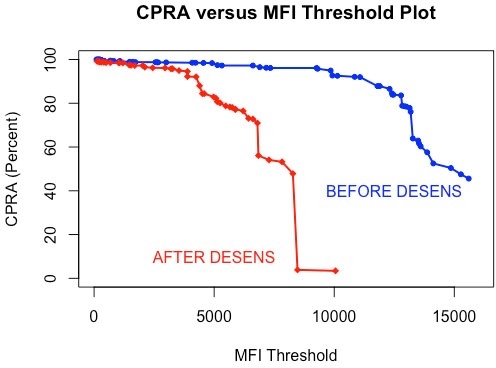Assessing Response to Desensitization: What Makes Sense?
Cedars Sinai Medical Center, Los Angeles.
Meeting: 2018 American Transplant Congress
Abstract number: B42
Keywords: Heart/lung transplantation, Sensitization, Waiting lists
Session Information
Session Name: Poster Session B: Heart and VADs: All Topics
Session Type: Poster Session
Date: Sunday, June 3, 2018
Session Time: 6:00pm-7:00pm
 Presentation Time: 6:00pm-7:00pm
Presentation Time: 6:00pm-7:00pm
Location: Hall 4EF
Purpose: Sensitized candidates experience prolonged waiting times for heart transplant (HT). Desensitization therapies can increase access to HT for sensitized candidates, but changes in calculated panel-reactive antibody (CPRA) are usually variable and small in magnitude. Here we sought to assess response to plasmapheresis/bortezomib (PP/BTZ) using 3 different methods: CPRA, likelihood of a compatible donor (LCD) and area under the mean fluorescence intensity (MFI) threshold curve (AUC).
Methods: We identified 25 HT candidates at our institution who received PP/BTZ prior to HT between 2010 and 2014. PP/BTZ included 8 sessions of PP and 4 doses of BTZ. HLA antibody analysis was performed by Luminex Single Antigen assay (OneLambda) before and after treatment. CPRA was calculated for each candidate using 3 MFI thresholds. Fold change in LCD was calculated as (1 – CPRA.final/1-CPRA.initial). E.g., decrease in CPRA from 90% to 80% is a 2-fold increase in donors. MFI threshold curves were constructed for each candidate by plotting the CPRA based on all HLA present at each MFI threshold and calculating AUC (FIGURE). All statistics were performed using R.
Results: Candidates were highly sensitized with a median CPRA of 96% (3,000 MFI threshold). At an MFI threshold of 3,000 MFI, 17 candidates (68%) responded with a median CPRA decrease of 1.3% and LCD increase of 1.5-fold. At an MFI threshold of 5,000 MFI, 16 candidates (60%) responded with a median CPRA decrease of 4.8% and LCD increase of 1.7-fold. At an MFI threshold of 10,000 MFI, 12 candidates (48%) responded with a median CPRA decrease of 12.3% and LCD increase of 1.7-fold. Using AUC, 20 candidates (80%) responded with a median relative decrease of -21%.
Conclusion: The number of candidates that respond to PP/BTZ desensitization varies depending on the method used to assess the antibody profile. Given that PP/BTZ resulted in CPRA changes of small magnitude, LCD and AUC are more representative parameters for determining access to HT and thus are better methods for assessing response to desensitization.
CITATION INFORMATION: Kransdorf E., Patel J., Kittleson M., Levine R., Dimbil S., Geft D., Chang D., Czer L., Kobashigawa J. Assessing Response to Desensitization: What Makes Sense? Am J Transplant. 2017;17 (suppl 3).
To cite this abstract in AMA style:
Kransdorf E, Patel J, Kittleson M, Levine R, Dimbil S, Geft D, Chang D, Czer L, Kobashigawa J. Assessing Response to Desensitization: What Makes Sense? [abstract]. https://atcmeetingabstracts.com/abstract/assessing-response-to-desensitization-what-makes-sense/. Accessed December 26, 2025.« Back to 2018 American Transplant Congress

